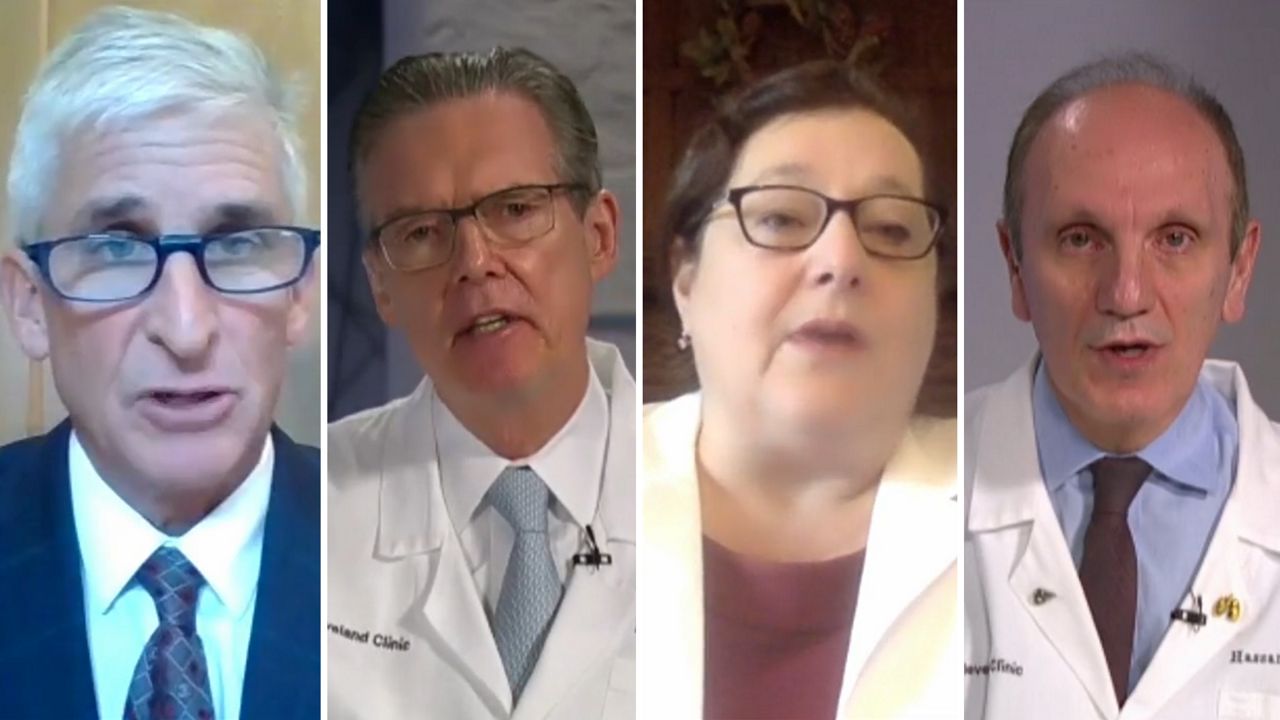CLEVELAND — Hospital officials with the Cleveland Clinic and University Hospitals said northern Ohio is recovering from the latest COVID-19 surge, though officials are unsure how long the downward trends will continue as colder weather sets in.
What You Need To Know
- Hospitalization numbers are declining in northern Ohio, but the impact of the virus is still significant for hospitals
- Officials with the Cleveland Clinic and University Hospitals raised concern about the state's low vaccination rate
- The two health systems are are awaiting federal decisions before requiring the vaccine for staff, officials said
During a virtual news conference Thursday afternoon, Dr. Robert Wyllie, chief of medical operations at the Cleveland Clinic, said virus hospitalizations in Ohio have declined by more than a third since the peak about a month ago.
“As we move into the fall, we're glad that we see the numbers going down, but we're concerned about what might happen as we look at the winter,” Wyllie said. “Just over 50% of Ohioans are vaccinated at this point, so there’s still plenty of people to potentially become infected.”
He said last year’s winter surge was fueled by people getting together indoors due to the cold weather as well as family gatherings for the holidays.
“I don't think any of us would be surprised if we didn't see an uptick again in the months of November and December or January, as we did last year,” Wyllie said. “We're looking at cycles of infection and we really don't understand the biology of the virus well enough to know why we have these rapid upswings in cases and then a plateau and then a downswing."
The Cleveland Clinic is still seeing about 90-100 patients per week in its Ohio intensive care units, according to Dr. Hassan Khouli, chair of the department of critical care medicine.
“Our teams are being very impacted as well. They have been going through this for a long time, since early last year. This is a long, long marathon,” he said. “What’s unfortunate about this current stage is that it is really preventable.”
Khouli said about 90% of Cleveland Clinic patients are unvaccinated, and those who are admitted, despite being fully vaccinated, tend to be older patients or individuals who have weaker immune systems.
“We’re seeing more and more young patients, patients who are young and requiring life-support treatment, including ventilators, and some of these patients, unfortunately, are dying from this disease, too,” he said.
Recently, some unvaccinated patients, or their families are asking for unproven treatments instead of evidence-based medication, complicating matters for care teams, he said.
Chief Scientific Officer of University Hospitals Dr. Daniel Simon discussed two therapeutics that are in development for COVID-19, Merck’s oral antiviral pill molnupiravir and Fluvoxamine, an antidepressant medication, that showed promise in a clinical trial, according to a Wednesday report in the Lancet, a medical journal.
“There's a lot of room for excitement today. We now have within our hands the Tamiflu equivalent for COVID-19,” Simon said. “Molnupiravir is at the FDA right now for EUA consideration, and we believe it will be available to patients by November.”
Simon said that many Ohioans, who are at greater risk for COVID-19, can get a vaccine booster for added protection. He said hospital officials recommend the Moderna and Pfizer vaccines as boosters, including for those who originally received the Johnson & Johnson shot.
Simon and Wyllie responded to questions from reporters about why the hospitals have not implemented vaccine requirements for their employees, whereas many of the state’s large hospitals have put requirements in place.
They said they are awaiting further word from the Occupational Safety and Health Administration and the Centers for Medicare & Medicaid Services about how the Biden administration’s plans to mandate vaccination will affect health systems. Both health systems said more than 80% of employees are vaccinated.
In addition to booster shots, Dr. Claudia Hoyen, director of pediatric infection control at UH Rainbow Babies and Children’s Hospital, discussed the anticipated authorization of the Pfizer BioNTech vaccine for children ages 5 to 11 next week.
Hoyen said she recommends that families seek opportunities to get vaccinate at their child’s pediatrician’s office.
“It's really best and safest for children to get their vaccines from their physicians,” she said.
For those who do not have a pediatrician, she said the health system and the Cuyahoga County Board of Health will have mass clinics around the Cleveland area.
A Centers for Disease Control and Prevention advisory committee is scheduled to consider the application for an emergency-use authorization on Tuesday.
Wyllie said the Cleveland Clinic will have more than 80 vaccine sites where children can get vaccinated, both in primary care offices and at large sites at the health system’s Fairview and Hillcrest hospitals.
During the latest surge, Hoyen said the children’s hospital saw a tenfold increase in COVID-19 hospitalizations, and while none of the patients died, some required ventilators, or treatment with ECMO machines, which support lung and heart function for critically ill patients.
She said while kids don’t get as sick as adults, COVID-19 is nonetheless the eighth leading cause of death among children. For those reasons, and the demonstrated safety of vaccines, she said the benefits outweigh the risks for children in the 5-11 age group.



